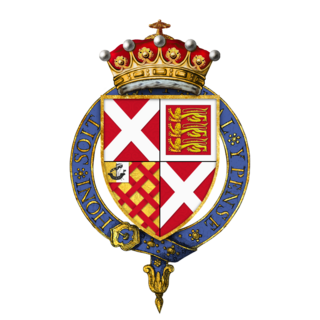Related Research Articles

Sir William Brooke, 10th Baron Cobham, KG, lord of the Manor of Cobham, Kent, was Lord Warden of the Cinque Ports, and a member of parliament for Hythe. Although he was viewed by some as a religious radical during the Somerset Protectorate, he entertained Queen Elizabeth I of England at Cobham Hall in 1559, signalling his acceptance of the moderate regime.

Anne of Gloucester, Countess of Stafford was the eldest daughter and eventually sole heiress of Thomas of Woodstock, 1st Duke of Gloucester, by his wife Eleanor de Bohun, one of the two daughters and co-heiresses of Humphrey de Bohun, 7th Earl of Hereford, 6th Earl of Essex (1341–1373) of Pleshey Castle in Essex.

The titles Baron Montacute or Baron Montagu were created several times in the Peerage of England for members of the House of Montagu. The family name was Latinised to de Monte Acuto, meaning "from the sharp mountain"; the French form is an ancient spelling of mont aigu, with identical meaning.
George Neville, or Nevill, 4th and de jure 2nd Baron Bergavenny was an English nobleman.

John Bourchier, 1st Baron Berners, KG was an English peer.

Thomas Burgh, 1st Baron Burgh also spelt Borough, KG, 1st Baron Borough of Gainsborough, also de jure 5th Baron Strabolgi and 7th Baron Cobham of Sterborough, was an English peer. In 1513 he was knighted on Flodden Field, where he was one of the King's Spears, a bodyguard of King Henry VIII. He later became Lord Chamberlain to Anne Boleyn. He was also one of the twenty-six Peers summoned to the trial of Anne Boleyn in May 1536.
George Neville, 1st Baron Latimer or (Latymer) was an English nobleman.
Margaret de Audley,suo jure2nd Baroness Audley and Countess of Stafford was an English noblewoman. She was the only daughter of Hugh de Audley, 1st Earl of Gloucester, by his wife Lady Margaret de Clare. Her mother was the daughter of Joan of Acre, Princess of England; thus making Margaret a great-granddaughter of King Edward I by his first consort, Eleanor of Castile. As the only daughter and heiress of her father, she succeeded to the title of 2nd Baroness Audley [E., 1317] on 10 November 1347.

Hugh de Stafford, 2nd Earl of Stafford, 3rd Baron Stafford, 3rd Baron Audley, KG was an English nobleman.
Philippa de Stafford, Countess of Stafford, was a late medieval English noblewoman and the daughter of Thomas de Beauchamp, 11th Earl of Warwick, KG, and Katherine Mortimer. Her maternal grandfather was the powerful Roger Mortimer, 1st Earl of March.

Ralph Neville, 4th Earl of WestmorlandKG, was an English peer and soldier. He was the grandson of Ralph Neville, 3rd Earl of Westmorland, and the father of Henry Neville, 5th Earl of Westmorland.
Edward Burgh, 2nd Baron Burgh of Gainsboroughde jure 4th Baron Strabolgi, was an English peer.
Edward Blount, 2nd Baron Mountjoy was an English peer.

Ralph Neville, 2nd Earl of Westmorland was an English nobleman in northern England.
Lady Alice Fiennes was the eldest daughter and co-heiress of Henry FitzHugh, 5th Baron FitzHugh, and Alice Neville. Alice was born at the ancestral castle of Ravensworth. She married Sir John Fiennes, the son of Sir Richard Fiennes and Joan Dacre, 7th Baroness Dacre. Alice was a first cousin of Queen consort Anne Neville and a great-aunt of Queen consort Catherine Parr.

Thomas Burgh, 3rd Baron Burgh KG 3rd Baron Borough of Gainsborough, de jure7th Baron Strabolgi and 9th Baron Cobham of Sterborough was the son of William Burgh, 2nd Baron Burgh and Lady Katherine Clinton, daughter of Edward Clinton, 1st Earl of Lincoln and Elizabeth Blount, former mistress of King Henry VIII. He was one of the peers who conducted the trial of the Duke of Norfolk in 1572.
Alice Neville, Baroness FitzHugh or Lady Alice FitzHugh, was the wife of Henry FitzHugh, 5th Baron FitzHugh. She is best known for being the great-grandmother of queen consort Catherine Parr and her siblings, Anne and William, as well as one of the sisters of Warwick the 'Kingmaker'. Her family was one of the oldest and most powerful families of the North. They had a long-standing tradition of military service and a reputation for seeking power at the cost of the loyalty to the crown as was demonstrated by her brother, the Earl of Warwick.
Sir Thomas Burgh (; BURRA, KG was an English gentleman.

Richard Neville, 2nd Baron Latimer KB of Snape, North Yorkshire, was an English soldier and peer. He fought at the battles of Stoke and Flodden.

The title Baron Cobham has been created numerous times in the Peerage of England; often multiple creations have been extant simultaneously, especially in the fourteenth century.
References
- Cokayne, George Edward, ed. (1913). Complete peerage of England, Scotland, Ireland, Great Britain and the United Kingdom, extant, extinct or dormant (Canonteign to Cutts). Vol. 3. London: The St. Catherine Press, ltd. p. 355.